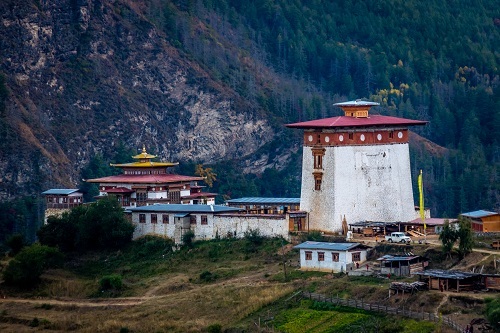
Planning a trip to Bhutan? Don’t miss the opportunity to visit one of the country’s oldest and most fascinating fortresses—Dobji Dzong.
Perched on a ridge near the scenic Haa Valley, this 16th-century Dzong offers a glimpse into Bhutan's rich cultural and spiritual heritage. With breathtaking views and spiritual significance, it’s a must-see for those wanting an authentic Bhutanese experience.
Know some interesting facts to understand why Dobji Dzong is a must-visit destination for any traveler seeking an authentic Bhutanese experience.
1. Dobji Dzong Is The Oldest Model Dzong In Bhutan
Dobji Dzong is considered to be the first model Dzong in Bhutan. Other names known locally include Dokar, Dogar, or Dobdrek Dzong. The name Dogar, which means white border, refers to the “Five White Boulders” in the village of Dogar. It is considered the prototype for Bhutan’s later Dzongs, influencing fortress designs across the country with its strategic positioning on a ridge for defense.
Dobji Dzong was built in 1531 by Ngawang Chogyal, the brother of Drukpa Kuenley, popularly known as the “Divine Madman.” It is situated below the spring “Drupchu,” which originated below the throne of Jetsun Milarepa in Tibet. The source of the spring was found to be a rock d in Paro at an altitude of 6,600 feet on the way to Haa in western Bhutan.

2. Dobji Dzong Was Inspired By A Sacred Spring Originating From Tibet
Legend has it that Ngawang Chogyal has followed the spring “Drupchu”, originating below the throne of Jetsun Milarepa in Tibet. The source of the spring was found to be a rock located on the current location of Dobji Dzong, which was then chosen for its religious significance.
Locals also visit the place because they believe spring water has healing properties. The main holy water site is located between the hills. It takes around 15 minutes to walk to the site from Dobji Dzong.
The mentioned spring is still visible today. However, Dobji Dzong was destroyed by a massive earthquake on September 2011. The remaining central tower was believed to have survived because of a Terma statue (the treasure statue of Guru Langdarchen).
3. The Dzong Served As A Central Jail Until 1997
The utse (tower) previously served as Dogar Penlop’s residential, and subsequently converted to become the central jail in 1976. It was later on converted into Jetsun Milarepa Lhakhang to propagate Drukpa Kagyu Buddhism. Dogar Dobji Dzong, according to Chencho Tshering Dorji’s PhD research article was discontinued as the central jail in 1997 after the residents expressed grievances and the dzong had suffered structural defects.
From serving as the main center to propagate Drukpa Kagyu Buddhism to housing Dobji Penlop and later as a central jail, Dogar Dobji Dzong has transitioned with changing times.
Today, the dzong houses a monastic school and religious relics such as the statue of Jetsun Milarepa, Ngawang Chogyal, Zhabdrung Ngawang Namgyel and Dunsay Dewa Zangpo. The sacred statue of Jetsun Mila was believed to be brought from Druk Ralung in Tibet.
While historically, people feared visiting the dzong for its dark history of housing the country’s most notorious prisoners. The dzong is currently buzzing with devotees daily.
4. Dobji Dzong Underwent Cultural Restoration After The 2021 Landslide
Following the 2021 landslide that caused significant damage to Dobji Dzong, the Bhutanese government, along with local communities and cultural preservation organizations, embarked on comprehensive restoration projects.
These efforts aimed to preserve the Dzong's architectural integrity and historical significance while incorporating modern techniques to enhance its resilience against future natural disasters.
The restoration process involved meticulous research to ensure authenticity, using traditional materials and craftsmanship. This revival not only safeguards a vital cultural landmark but also reinforces Bhutan's commitment to preserving its rich heritage for future generations.
5. A Hidden Gem In The Haa Valley
Unlike more frequently visited Dzongs in Bhutan, Dobji Dzong is nestled in the serene and less-traveled Haa Valley. This unique location offers travelers an off-the-beaten-path experience away from the bustling tourist spots.
The Haa Valley itself is renowned for its unspoiled natural beauty, vibrant local culture, and warm hospitality of the Bhutanese people.
Exploring Dobji Dzong in this tranquil setting allows visitors to immerse themselves in authentic Bhutanese life, partake in local festivals, and enjoy activities such as hiking, bird-watching, and interacting with local artisans.
This hidden gem provides a unique and enriching experience for those seeking to explore Bhutan beyond the conventional tourist trails.
Conclusion About Fascinating Facts About Dobji Dzong
Dobji Dzong stands out for its stunning panoramic views, spiritual significance, and unique location in the peaceful Haa Valley. As Bhutan’s first model Dzong, it offers a glimpse into the country’s deep-rooted traditions and history.
Visiting Dobji Dzong allows travelers to experience Bhutan’s natural beauty alongside its rich cultural heritage. To ensure you don’t miss this hidden gem, Druk Asia, a trusted Bhutan tour operator, offers comprehensive cultural, adventure, and trekking tour packages that include Dobji Dzong and other iconic destinations across the Kingdom.
Start planning your Bhutan adventure today with Druk Asia!
Frequently Asked Questions About Dobji Dzong
Why Is Dobji Dzong Historically Significant?
Dobji Dzong is Bhutan's first model Dzong, setting the architectural standard for later fortresses.
What Can Visitors See At Dobji Dzong?
Visitors can explore the Dzong's monastic school, religious relics, and enjoy stunning views of the surrounding valleys.
Is There An Entrance Fee For Visiting Dobji Dzong?
No, visiting Dobji Dzong is generally free, though it is best to confirm through local travel operators.
What Is The Best Time To Visit Dobji Dzong?
The best time to visit is during Bhutan's spring (March-May) and fall (September-November) for ideal weather and clear views.
